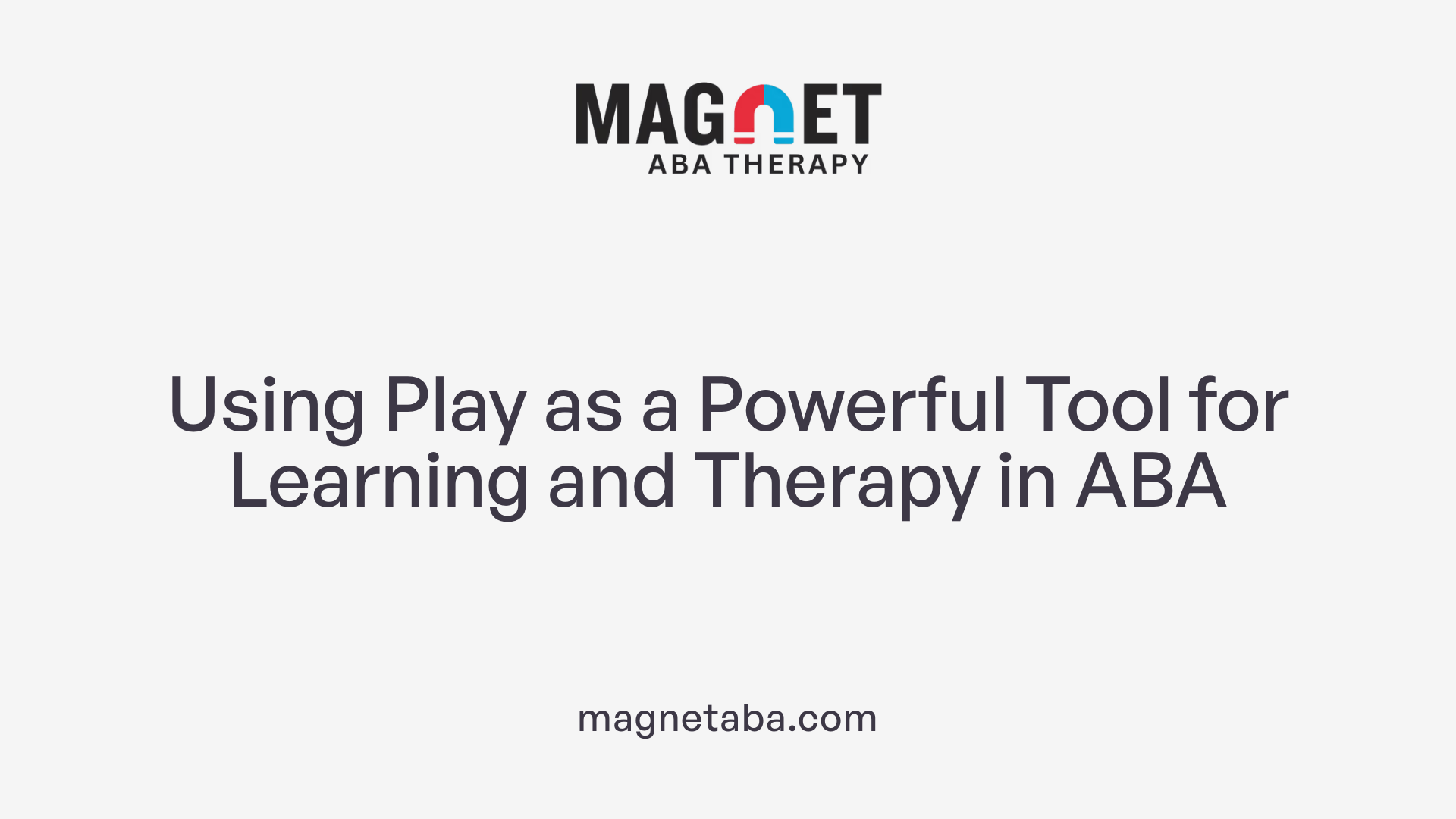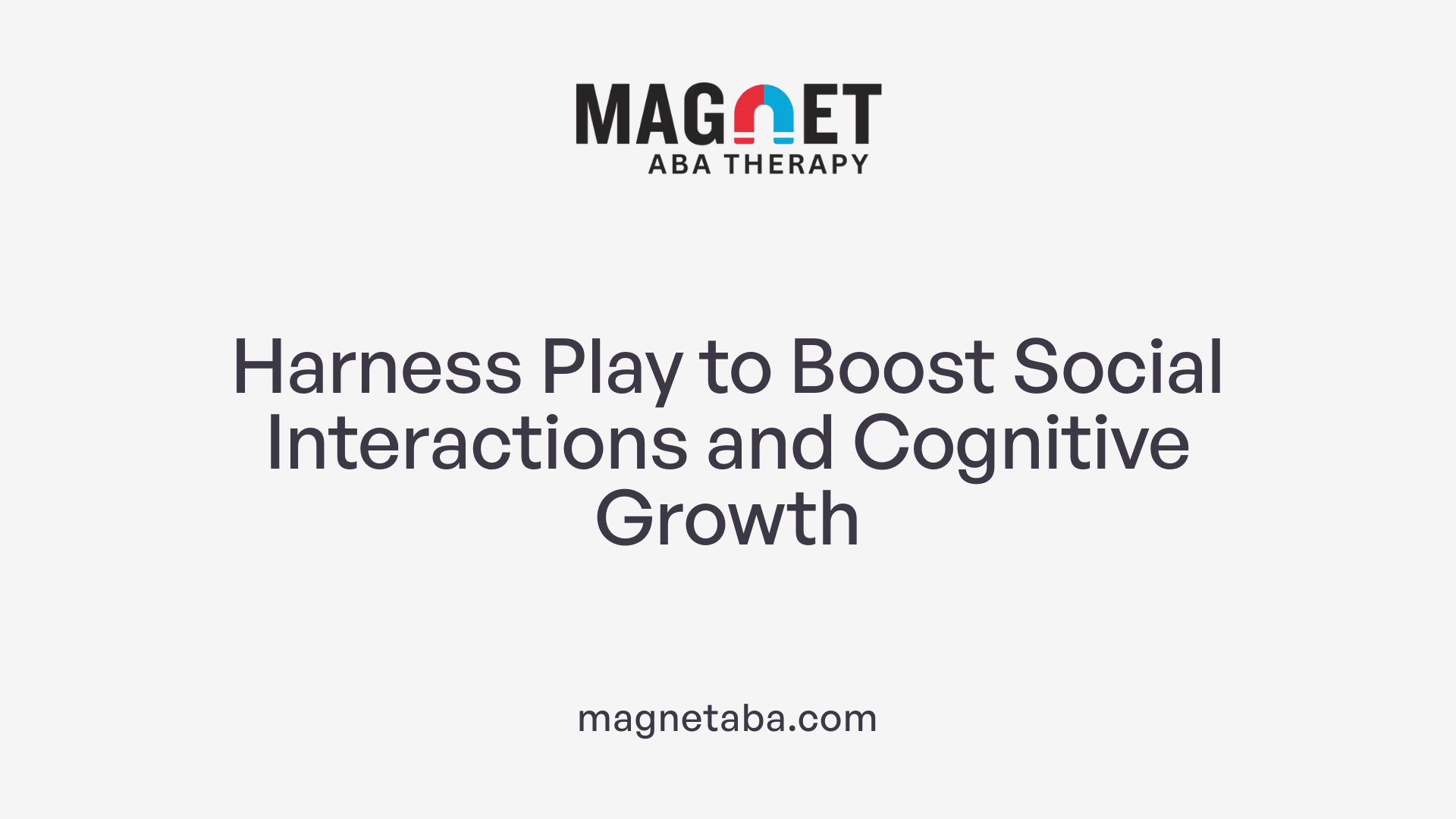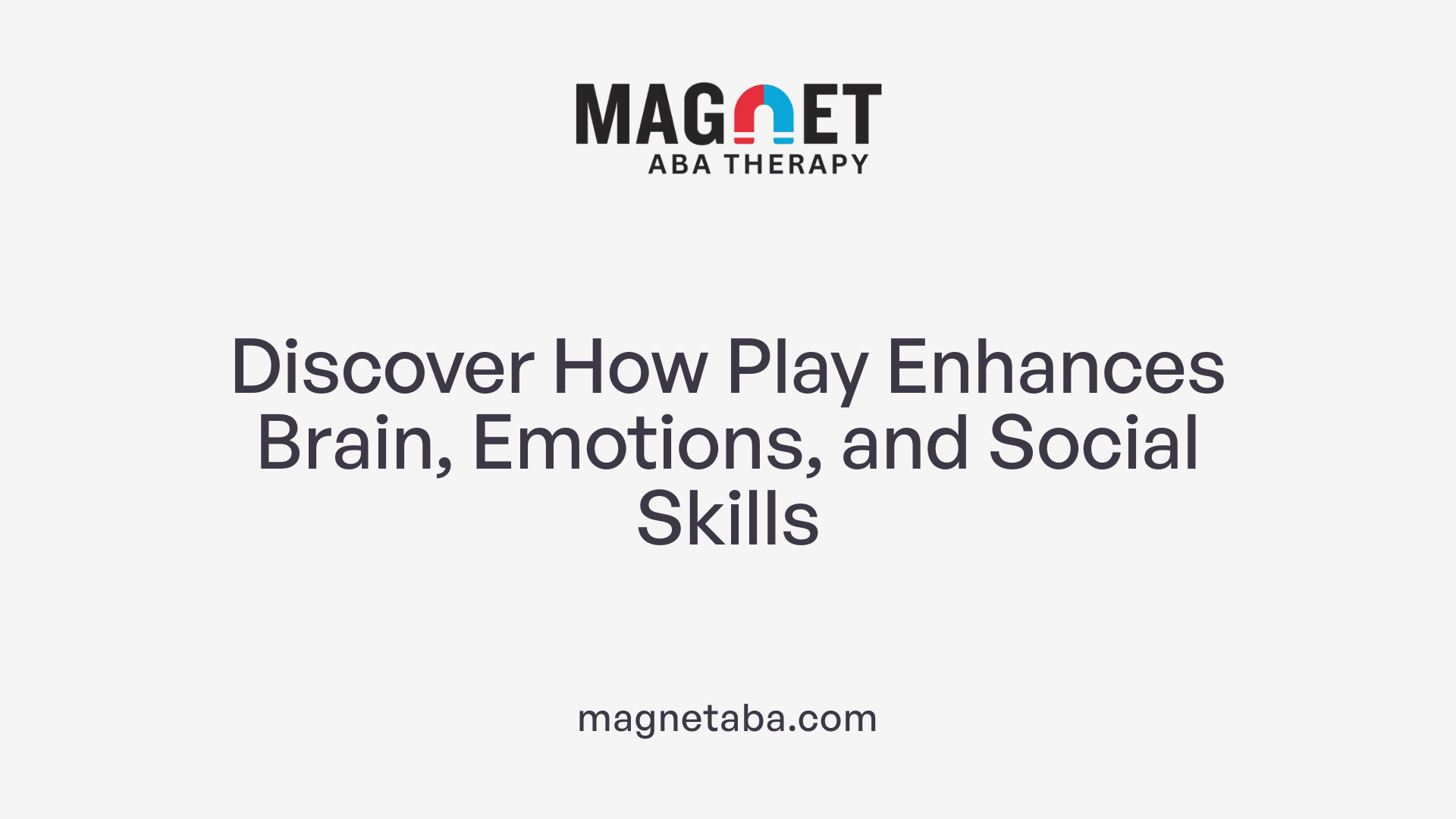Introduction to ABA and Play-Based Interventions
Applied Behavior Analysis (ABA) is a scientifically supported approach that utilizes play as a fundamental tool in teaching children with autism essential social, communication, and cognitive skills. By integrating various forms of play into intervention strategies, ABA creates engaging, naturalistic learning environments. These settings facilitate skill acquisition while encouraging motivation and positive behaviors, making therapy both effective and enjoyable for children.
Utilization of Play as an Instructional and Therapeutic Tool in ABA
 Play serves as a core component in Applied Behavior Analysis (ABA) therapy, providing a natural, engaging, and motivating context for teaching children essential skills. It creates an environment where children can learn communication, social interaction, and adaptive behaviors through enjoyable activities.
Play serves as a core component in Applied Behavior Analysis (ABA) therapy, providing a natural, engaging, and motivating context for teaching children essential skills. It creates an environment where children can learn communication, social interaction, and adaptive behaviors through enjoyable activities.
Different play types—such as structured play, free play, and sensory or messy play—are used strategically within ABA to target specific goals. Structured play involves activities with clear routines and visual supports, helping children learn rules, turn-taking, and cooperation. Free or unstructured play encourages spontaneous interaction, fostering creativity and social skills like empathy. Sensory play offers rich tactile experiences, which can help children regulate emotions, seek help, and work collaboratively.
ABA therapists employ various techniques during play-based interventions. Visual supports and prompts guide children through tasks, while reinforcement encourages positive behaviors and skill acquisition. Child-centered approaches ensure activities are tailored to individual interests, making learning enjoyable. Play activities such as storytelling, puzzles, and role-playing not only teach social and communication skills but also aid in the generalization of these behaviors across real-life settings.
Involving parents in play-based ABA strategies is crucial. It allows parents to reinforce skills at home and in other environments, ensuring consistency and promoting the child's progress beyond therapy sessions. This comprehensive approach makes play a highly effective method for developing social, cognitive, and communication skills, ultimately helping children with autism to better navigate their social worlds.
The Role of Play in Supporting Social and Cognitive Skills Development

How does ABA support collaborative play and contribute to children's social development?
Applied Behavior Analysis (ABA) is a widely used, evidence-based approach to help children improve their social and communication skills through structured play activities. In collaborative play, children learn essential social behaviors such as sharing, turn-taking, and understanding social cues.
ABA therapy incorporates techniques like role-playing and modeling during play, encouraging children to initiate interactions and respond appropriately. Social skills groups and natural environment teaching are also employed to promote real-life social engagement.
Positive reinforcement is a core element of ABA, motivating children to practice desirable behaviors repeatedly. This approach helps children become motivated and engaged in group settings, making play a natural context for social learning.
Research supports ABA's effectiveness in enhancing social communication, peer engagement, and emotional regulation. As children develop these skills, they are more likely to participate actively in group activities, form friendships, and navigate social situations with confidence.
Through targeted strategies, ABA helps children with autism make meaningful progress in social skills, fostering stronger, more cooperative relationships that support their overall development.
How can play be used to develop communication, cognitive, and emotional skills?
Play is a vital tool for building communication skills in children. Activities like storytelling, pretend play, and turn-taking games help children practice verbal and nonverbal communication. These interactions provide opportunities to request items, share ideas, and engage in dialogues.
Cognitive development is also supported through puzzles, sequencing activities, and problem-solving games. These challenges enhance memory, pattern recognition, and logical thinking.
Messy and sensory play, such as playing with textured materials or engaging in hands-on activities, encourages children to seek help and collaborate. Such play fosters emotional learning by helping children manage sensory inputs and express their emotions.
In therapy settings, incorporating various play types—structured, functional, social, and free play—creates a rich environment for development. Each type of play targets specific goals, making learning enjoyable and engaging.
Overall, play serves as a natural, motivating context for children to develop crucial social, communication, and cognitive skills, laying a strong foundation for their ongoing growth.
Strategies and Techniques Used in ABA to Foster Collaborative Play

What strategies and techniques are used in ABA to facilitate collaborative play among children with autism?
Applied Behavior Analysis (ABA) employs various methods to support children with autism in engaging in cooperative play. These include modeling, prompting, reinforcement, and scenario-based training.
Modeling involves demonstrating desired play behaviors so children can observe and imitate social interactions. Prompting provides cues or hints to guide children toward appropriate play actions, gradually fading as they gain independence.
Reinforcement is used to encourage positive social behaviors, offering praise or rewards when children successfully participate in collaborative activities. Scenario-based training creates realistic play situations where children can practice turn-taking, sharing, and other social skills.
Play activities such as storytelling, role-playing, and turn-taking games serve as engaging platforms to promote language development and emotional understanding. These activities are designed to be fun and motivating, making learning an enjoyable experience.
In addition, reciprocal play—like sharing, joint attention, and joint activities—helps children learn social cues and build friendships. Visual supports such as schedules and social stories clarify expectations, reduce anxiety, and enhance comprehension.
Structured routines and consistent reinforcement help children understand the structure of social play and develop trust in the process. Overall, ABA integrates play as a natural, effective way to foster social skills, communication skills, and emotional regulation, setting the foundation for meaningful social interactions.
Evidence Supporting ABA's Effectiveness in Promoting Collaborative Play
Research findings from peer-reviewed studies and scientific literature consistently indicate that Applied Behavior Analysis (ABA) is a proven approach for fostering collaborative play skills in children with autism. ABA uses targeted strategies like Discrete Trial Training (DTT), Natural Environment Teaching (NET), role-playing, and social skills groups to address specific social and play challenges.
Empirical evidence shows that these interventions significantly improve reciprocal communication, social engagement, and emotional regulation in children with autism. For example, role-playing activities in ABA help children practice real-life social interactions, promoting cooperation and joint attention.
Furthermore, social group sessions facilitated within ABA frameworks encourage children to develop sharing, turn-taking, and group cooperation skills. These activities create a natural setting for children to build relationships, boosting their confidence and social understanding.
Overall, multiple peer-reviewed articles affirm that ABA is a well-established, effective intervention. Its focus on reinforcing positive behaviors through play makes it a powerful tool for helping children with autism develop essential social skills. As a result, ABA contributes significantly to improving social inclusion and overall quality of life for children on the spectrum.
| Strategy | Purpose | Outcomes |
|---|---|---|
| Discrete Trial Training (DTT) | Breaking down skills into small, manageable steps | Improve targeted play and social behaviors |
| Natural Environment Teaching (NET) | Learning through everyday activities | Enhance spontaneous social interaction |
| Role-playing | Practicing social scenarios | Foster real-life social skills |
| Social Skills Groups | Group-based activities | Develop cooperation, sharing, and joint attention |
This comprehensive approach solidifies ABA’s role in promoting social and collaborative play in children with autism, supporting their broader social development and community integration.
Integrating Play into Daily Life and Therapy Settings

How can play be incorporated into home, school, and therapy environments?
Play is an adaptable tool that seamlessly fits into various settings, making learning and social development more engaging for children with autism. At home, parents can introduce simple games like turn-taking activities or puzzles to promote communication and problem-solving skills. In school, teachers can incorporate group activities, pretend play, or sensory-rich messy play to encourage collaboration and social interaction. Therapy centers often use structured play routines, including games and role-playing scenarios, tailored to each child's developmental goals.
How can play support ongoing development across different settings?
Consistent use of play-based activities across home, school, and therapy helps reinforce skills learned in one environment within others. For example, a child practicing sharing during a game at home can transfer that behavior to a group activity at school. Play activities like storytelling and sequencing tasks boost language and cognitive skills across all settings. Repetition and variety in play ensure progress in social, communication, and problem-solving abilities.
How can creating routines with play benefit children with autism?
Establishing predictable routines with regular play times helps children feel secure and understand expectations. Using visual reminders, timers, and cue cards during play can make routines clear and manageable. Gradually introducing new play activities and inviting peers or family members increases comfort and social engagement. Consistent routines foster a sense of stability, making interactions more effective and enjoyable.
How can families and caregivers be involved in play-based strategies?
Families play a critical role in reinforcing skills through daily play activities. Caregivers can learn and use strategies like guided pretend play, turn-taking games, and sensory activities to promote social and communication skills. Participating in therapy-recommended play routines helps children generalize their learning across environments. Training sessions or workshops enable families to incorporate play techniques effectively, ensuring continuous development and a stronger parent-child bond.
The Broader Impact of Play on Children’s Overall Development

Neural development and neuroplasticity benefits of play
Engaging in play stimulates the brain’s growth and adaptability, known as neuroplasticity. When children participate in activities like building structures or playing games, they reinforce neural connections that support cognitive functions, attention, and memory. Play encourages the brain to form new pathways, which is vital for learning and adapting to new situations.
Building resilience and emotional regulation through play
Play provides children with opportunities to experience and manage emotions in a safe environment. Through role-playing and imaginative scenarios, children learn to cope with frustrations, develop patience, and express feelings appropriately. This emotional regulation is crucial for building resilience, helping children bounce back from setbacks and challenges.
Fostering independence and social inclusion
Participating in cooperative and group play promotes independence by encouraging decision-making and problem-solving. It also helps children develop social skills like negotiation, empathy, and communication, essential for social inclusion. Whether in structured ABA activities or free play with peers, children learn to collaborate, share, and respect differences, fostering a sense of belonging.
Summary and Final Thoughts on Play in ABA
Play forms a cornerstone of ABA therapy, serving as a highly effective and engaging method to foster social, communication, and cognitive skills in children with autism. Its versatility across different types of play and settings makes it an essential component for promoting lifelong social competence and emotional resilience, ultimately supporting children’s integration into their communities and daily life.
References
- Cooperative Pretend Play: Helping Your Child Gain Social Skills
- The Role of Play in ABA Therapy: Making Therapy Fun
- Using Play as a Teaching Tool in ABA Therapy
- The effectiveness of applied behavior analysis program training on ...
- Applied Behavior Analysis (ABA) | Autism Speaks
- Harnessing ABA Therapy for Social Skills Development in Autism
- Applied Behavior Analysis in Children and Youth with Autism ...
- Using ABA to Improve Social Skills in Children with Autism











